Identification of NO2 and SO2 Pollution Hotspots and Sources in Jiangsu Province of China
Abstract
:1. Introduction
2. Materials and Methods
2.1. Study Area
2.2. OMI Data
2.3. Research Methodology
- The daily OMI-based NO2 and SO2 data were averaged to seasonal and annual scales. For annual and seasonal analysis, point data for 13 cities and the entire Jiangsu Province were extracted using the city-level shapefile.
- The Mann–Kendal test was used to calculate trends, while Sen’s slope method was used to derive the magnitudes of NO2 and SO2 trends. The following steps were used to calculate trends:
- The Hybrid Single-Particle Lagrangian Integrated Trajectory (HYSPLIT) model from the US National Oceanic and Atmospheric Administration (NOAA) [66] is a complete dispersion, transport, and chemical transformation model. This HYSPLIT model has been used to discover the sources of air masses using back-trajectory analysis [67], and PSCF analysis represents the potential sources of gaseous pollutants impacting China’s air quality. In this study, 72 h HYSPLIT back trajectories at 500 m above ground level (AGL) were calculated for every hour at seasonal scales from 2014 to 2020 using the Global Data Assimilation System (GDAS)-based meteorological data with a spatial resolution of 1° × 1° (link: ftp://arlftp.arlhq.noaa.gov/pub/archives/gdas1, accessed date: 25 July 2021). Begum et al. [68] reported that 500 m height is suitable for representing pollution as it is the representative height of the mixed layer. MeteoInfo TrajStat software [69] in conjunction with HYSPLIT and MATLAB were used to compute the back-trajectory clustering and investigate the origins of gaseous pollutants (NO2 and SO2) in Jiangsu Province. The typical lifetime of NO2 (SO2) is around 6 h (15 h) in summer and 21 h (65 h) in winter [70,71]; therefore, in this study, PSCF analysis was based on 72 h back trajectory from the HYSPLIT model combining with hourly surface measurements. The PSCF analysis used hourly surface-based NO2 and SO2 concentrations over a grid size of 0.5 × 0.5 degrees. Furthermore, the study used 1 hourly MEP-based surface NO2 and SO2 data from 91 sites in 13 cities of Jiangsu Province (link: http://106.37.208.233:20035/, accessed date: 25 July 2021). The PSCF value was calculated based on the assumption that the trajectory endpoint is located within a grid cell (i, j), and the trajectory was assumed to collect pollutants emitted from different pocket emission sources within that cell (i, j). The PSCF value can be explained as a conditional probability that defines the potential contributions of a grid cell to the high NO2 and SO2 loadings at the receptor sites. The value of the PSCF for the ijth grid cell is calculated based on the following Equation (6):where nij is the number of endpoints that fall or pass through the ijth cell and mij defines the number of endpoints in the ijth cell having a concentration higher than an arbitrarily set criterion of the 75 percentile. For the two pollutants NO2 and SO2, the thresholds were 46.875 µg/m3 and 20.143 µg/m3, respectively. To reduce the uncertainty of the PSCF that resulted from small nij, an arbitrary weight function (Wi,j) is multiplied into the PSCF (Equation (7)):
3. Results and Discussion
3.1. Spatial Distributions of NO2 and SO2
3.2. Frequency Distributions of NO2 and SO2
3.3. Ratio of SO2/NO2 Indicator for Pollution Level
3.4. NO2 and SO2 Trends
3.5. Source Identification of NO2 and SO2 Using PSCF Analysis
4. Conclusions
- The hotspots of NO2 and SO2 (DU) were found in most cities of Jiangsu Province, as indicated by high values of NO2 and SO2 (>0.60 DU). Long-term (2005–2020) city-level annual mean NO2 showed its highest value in Wuxi and SO2 in Xuzhou due to the dominance of local anthropogenic activities over these regions. However, both NO2 and SO2 found their lowest levels in Yancheng City.
- Seasonally, both NO2 and SO2 showed their highest values in winter due to increased anthropogenic emission activities (coal-based burning for room heating in the cold season) and stable atmospheric conditions (stagnant conditions and a shallower boundary layer). In contrast, both NO2 and SO2 were lowest in summer due to heavy precipitation, which washes out the pollution from the atmosphere.
- The occurrence frequencies of NO2 and SO2 were relatively common for the 0.3–0.6 bins. Notably, the high level of pollution across Jiangsu Province was identified by the NO2 and SO2 > 1.2 bin, and the occurrence frequency of NO2 and SO2 was highest in winter than in other seasons.
- High SO2/NO2 ratio values (>0.60) indicate industry as the dominant source, with significant annual and seasonal fluctuations. The long-term (2005–2020) SO2/NO2 ratio showed its highest in Lianyungang and Yancheng (1.04) and lowest in Suzhou and Wuxi (0.78), suggesting that industrial activities contribute to high SO2 pollution due to the use of high-sulfur coals. Seasonally, the SO2/NO2 ratio was highest in spring (0.83~1.22), followed by summer (0.88~1.15), autumn (0.74~1.10), and winter (0.69~0.95).
- Annually, NO2 showed decreasing trends (DU/year) at a larger magnitude during 2011-2015 (−0.024~−0.052) compared to 2013-2017 (−0.007~−0.043) and 2005–2020 (−0.002 to −0.012) and increasing trends during 2006–2010 (0.015 to 0.031). NO2 also showed decreasing trends during 2005–2020, 2011–2015, and 2013–2017 and an increasing trend in 2006–2010 for all seasons.
- Decreasing trends in SO2 (DU/year) were more prominent during 2011–2015 (−0.002~−0.075) than in 2006–2010 (−0.014~−0.071), 2013–2017 (−0.007~−0.043), and 2005–2020 (−0.015~−0.032). As with the annual trends, decreasing trends in SO2 were also evident in all seasons.
- PSCF analysis indicated that Jiangsu’s air quality is strongly affected by anthropogenic sources located inside China, with some contributions from neighboring countries (e.g., Bangladesh, Kazakhstan, Mongolia, India, Nepal, Russia, and Tajikistan).
Supplementary Materials
Author Contributions
Funding
Institutional Review Board Statement
Informed Consent Statement
Data Availability Statement
Acknowledgments
Conflicts of Interest
References
- Wang, Y.; Ali, A.; Bilal, M.; Qiu, Z.; Ke, S.; Almazroui, M.; Islam, M.; Zhang, Y. Identification of Aerosol Pollution Hotspots in Jiangsu Province of China. Remote Sens. 2021, 13, 2842. [Google Scholar] [CrossRef]
- Chan, C.K.; Yao, X. Air pollution in mega cities in China. Atmos. Environ. 2008, 42, 1–42. [Google Scholar] [CrossRef]
- Li, F.; Song, Z.; Liu, W. China’s energy consumption under the global economic crisis: Decomposition and sectoral analysis. Energy Policy 2014, 64, 193–202. [Google Scholar] [CrossRef]
- Yuan, Y.; Liu, S.; Castro, R.; Pan, X. PM2.5 Monitoring and Mitigation in the Cities of China. Environ. Sci. Technol. 2012, 46, 3627–3628. [Google Scholar] [CrossRef]
- Chang, Y. China Needs a Tighter PM2.5 Limit and a Change in Priorities. Environ. Sci. Technol. 2012, 46, 7069–7070. [Google Scholar] [CrossRef] [Green Version]
- Hao, J.; Zhu, T.; Fan, X. Indoor Air Pollution and Its Control in China. In Indoor Air Pollution. The Handbook of Environmental Chemistry; Springer: Berlin/Heidelberg, Germany, 2014; Volume 64, pp. 145–170. [Google Scholar] [CrossRef]
- Wang, S.W.; Zhang, Q.; Streets, D.G.; He, K.B.; Martin, R.V.; Lamsal, L.N.; Chen, D.; Lei, Y.; Lu, Z. Growth in NOx emissions from power plants in China: Bottom-up estimates and satellite observations. Atmos. Chem. Phys. Discuss. 2012, 12, 4429–4447. [Google Scholar] [CrossRef] [Green Version]
- Slezakova, K.; Pires, J.; Martins, F.; Pereira, M.; Alvim-Ferraz, M. Identification of tobacco smoke components in indoor breathable particles by SEM–EDS. Atmos. Environ. 2011, 45, 863–872. [Google Scholar] [CrossRef]
- WHO. Regional Office Air Quality Guidelines. In Air Quality Guidelines for Europe; WHO: Geneva, Switzerland, 2000. [Google Scholar]
- IPCC. Climate Change 2007. The Physical Science Basis: Working Group I Contribution to the Fourth Assessment Report of the IPCC., Science (80-.); Cambridge University Press: Cambridge, UK, 2007. [Google Scholar]
- He, Y.; Uno, I.; Wang, Z.; Ohara, T.; Sugimoto, N.; Shimizu, A.; Richter, A.; Burrows, J.P. Variations of the increasing trend of tropospheric NO2 over central east China during the past decade. Atmos. Environ. 2007, 41, 4865–4876. [Google Scholar] [CrossRef]
- Shon, Z.-H.; Kim, K.-H.; Song, S.K. Long-term trend in NO2 and NOx levels and their emission ratio in relation to road traffic activities in East Asia. Atmos. Environ. 2011, 45, 3120–3131. [Google Scholar] [CrossRef]
- Kajino, M.; Ueda, H.; Sato, K.; Sakurai, T. Spatial distribution of the source-receptor relationship of sulfur in Northeast Asia. Atmos. Chem. Phys. Discuss. 2011, 11, 6475–6491. [Google Scholar] [CrossRef] [Green Version]
- Richter, A.; Wittrock, F.; Burrows, J.P. SO2 measurements with SCIAMACHY. In Proceedings of the European Space Agency; ESA SP: Bremen, Germany, 2006. [Google Scholar]
- Dickerson, R.R.; Li, C.; Li, Z.; Marufu, L.T.; Stehr, J.W.; McClure, B.; Krotkov, N.; Chen, H.; Wang, P.; Xia, X.; et al. Aircraft observations of dust and pollutants over northeast China: Insight into the meteorological mechanisms of transport. J. Geophys. Res. Space Phys. 2007, 112. [Google Scholar] [CrossRef] [Green Version]
- Richter, A.; Burrows, J. Tropospheric NO2 from GOME measurements. Adv. Space Res. 2002, 29, 1673–1683. [Google Scholar] [CrossRef]
- Cheng, M.; Jiang, H.; Guo, Z. Evaluation of long-term tropospheric NO2 columns and the effect of different ecosystem in Yangtze River Delta. Procedia Environ. Sci. 2012, 13, 1045–1056. [Google Scholar] [CrossRef] [Green Version]
- Schumann, U.; Huntrieser, H. The global lightning-induced nitrogen oxides source. Atmos. Chem. Phys. Discuss. 2007, 7, 3823–3907. [Google Scholar] [CrossRef] [Green Version]
- Vinken, G.C.M.; Boersma, K.F.; Maasakkers, J.D.; Adon, M.; Martin, R.V. Worldwide biogenic soil NOx emissions inferred from OMI NO2 observations. Atmos. Chem. Phys. 2014, 14, 18. [Google Scholar] [CrossRef] [Green Version]
- Zhang, L.; Lee, C.S.; Zhang, R.; Chen, L. Spatial and temporal evaluation of long term trend (2005–2014) of OMI retrieved NO2 and SO2 concentrations in Henan Province, China. Atmos. Environ. 2017, 154, 151–166. [Google Scholar] [CrossRef]
- Krotkov, N.A.; McLinden, C.A.; Li, C.; Lamsal, L.N.; Celarier, E.A.; Marchenko, S.V.; Swartz, W.H.; Bucsela, E.J.; Joiner, J.; Duncan, B.N.; et al. Aura OMI observations of regional SO2 and NO2 pollution changes from 2005 to 2015. Atmos. Chem. Phys. Discuss. 2016, 16, 4605–4629. [Google Scholar] [CrossRef] [Green Version]
- Haq, Z.U.; Tariq, S.; Ali, M. Tropospheric NO2Trends over South Asia during the Last Decade (2004–2014) Using OMI Data. Adv. Meteorol. 2015, 2015, 1–18. [Google Scholar] [CrossRef] [Green Version]
- Zheng, C.; Zhao, C.; Li, Y.; Wu, X.; Zhang, K.; Gao, J.; Qiao, Q.; Ren, Y.; Zhang, X.; Chai, F. Spatial and temporal distribution of NO2 and SO2 in Inner Mongolia urban agglomeration obtained from satellite remote sensing and ground observations. Atmos. Environ. 2018, 188, 50–59. [Google Scholar] [CrossRef] [Green Version]
- Guo, H.; Gu, X.; Ma, G.; Shi, S.; Wang, W.; Zuo, X.; Zhang, X. Spatial and temporal variations of air quality and six air pollutants in China during 2015–2017. Sci. Rep. 2019, 9, 1–11. [Google Scholar] [CrossRef] [Green Version]
- Lin, J.-T.; McElroy, M.B. Detection from space of a reduction in anthropogenic emissions of nitrogen oxides during the Chinese economic downturn. Atmos. Chem. Phys. Discuss. 2011, 11, 8171–8188. [Google Scholar] [CrossRef] [Green Version]
- Hilboll, A.; Richter, A.; Burrows, J.P. Long-term changes of tropospheric NO2 over megacities derived from multiple satellite instruments. Atmos. Chem. Phys. Discuss. 2013, 13, 4145–4169. [Google Scholar] [CrossRef] [Green Version]
- Zhang, L.; Jacob, D.J.; Boersma, K.F.; Jaffe, D.A.; Olson, J.R.; Bowman, K.W.; Worden, J.R.; Thompson, A.M.; Avery, M.A.; Cohen, R.C.; et al. Transpacific transport of ozone pollution and the effect of recent Asian emission increases on air quality in North America: An integrated analysis using satellite, aircraft, ozonesonde, and surface observations. Atmos. Chem. Phys. Discuss. 2008, 8, 6117–6136. [Google Scholar] [CrossRef] [Green Version]
- Wang, S.; Xing, J.; Chatani, S.; Hao, J.; Klimont, Z.; Cofala, J.; Amann, M. Verification of anthropogenic emissions of China by satellite and ground observations. Atmos. Environ. 2011, 45, 6347–6358. [Google Scholar] [CrossRef]
- Lu, Z.; Streets, D.; de Foy, B.; Krotkov, N. Ozone Monitoring Instrument Observations of Interannual Increases in SO2 Emissions from Indian Coal-Fired Power Plants during 2005–2012. Environ. Sci. Technol. 2013, 47, 13993–14000. [Google Scholar] [CrossRef] [PubMed]
- Burrows, J.P.; Weber, M.; Buchwitz, M.; Rozanov, V.; Ladstätter-Weißenmayer, A.; Richter, A.; DeBeek, R.; Hoogen, R.; Bramstedt, K.; Eichmann, K.-U.; et al. The Global Ozone Monitoring Experiment (GOME): Mission Concept and First Scientific Results. J. Atmos. Sci. 1999, 56, 151–175. [Google Scholar] [CrossRef]
- Eisinger, M.; Burrows, J.P. Tropospheric sulfur dioxide observed by the ERS-2 GOME instrument. Geophys. Res. Lett. 1998, 25, 4177–4180. [Google Scholar] [CrossRef] [Green Version]
- Bovensmann, H.; Burrows, J.P.; Buchwitz, M.; Frerick, J.; Noël, S.; Rozanov, V.V.; Chance, K.; Goede, A.P.H. SCIAMACHY: Mission Objectives and Measurement Modes. J. Atmos. Sci. 1999, 56, 127–150. [Google Scholar] [CrossRef] [Green Version]
- Munro, R.; Anderson, C.; Callies, J.; Corpaccioli’, E.; Eisinger, M.; Lang, R.; Lefebvre, A.; Livschitz, Y.; Albiñana, A.P. GOME-2 on MetOp. In Proceedings of the European Space Agency; ESA SP: Bremen, Germany, 2006. [Google Scholar]
- Munro, R.; Lang, R.; Klaes, D.; Poli, G.; Retscher, C.; Lindstrot, R.; Huckle, R.; Lacan, A.; Grzegorski, M.; Holdak, A.; et al. The GOME-2 instrument on the Metop series of satellites: Instrument design, calibration, and level 1 data processing—an overview. Atmos. Meas. Tech. 2016, 9, 1279–1301. [Google Scholar] [CrossRef] [Green Version]
- Levelt, P.; Hilsenrath, E.; Leppelmeier, G.; Oord, G.V.D.; Bhartia, P.; Tamminen, J.; De Haan, J.; Veefkind, J. Science objectives of the ozone monitoring instrument. IEEE Trans. Geosci. Remote. Sens. 2006, 44, 1199–1208. [Google Scholar] [CrossRef]
- Levelt, P.; Oord, G.V.D.; Dobber, M.; Malkki, A.; Visser, H.; De Vries, J.; Stammes, P.; Lundell, J.; Saari, H. The ozone monitoring instrument. IEEE Trans. Geosci. Remote Sens. 2006, 44, 1093–1101. [Google Scholar] [CrossRef]
- Veefkind, J.; Aben, I.; McMullan, K.; Förster, H.; de Vries, J.; Otter, G.; Claas, J.; Eskes, H.; de Haan, J.; Kleipool, Q.; et al. TROPOMI on the ESA Sentinel-5 Precursor: A GMES mission for global observations of the atmospheric composition for climate, air quality and ozone layer applications. Remote Sens. Environ. 2012, 120, 70–83. [Google Scholar] [CrossRef]
- Levelt, P.F.; Joiner, J.; Tamminen, J.; Veefkind, J.P.; Bhartia, P.K.; Zweers, D.C.S.; Duncan, B.N.; Streets, D.G.; Eskes, H.; van der A, R.; et al. The Ozone Monitoring Instrument: Overview of 14 years in space. Atmos. Chem. Phys. Discuss. 2018, 18, 5699–5745. [Google Scholar] [CrossRef] [Green Version]
- Damiani, A.; De Simone, S.; Rafanelli, C.; Cordero, R.; Laurenza, M. Three years of ground-based total ozone measurements in the Arctic: Comparison with OMI, GOME and SCIAMACHY satellite data. Remote Sens. Environ. 2012, 127, 162–180. [Google Scholar] [CrossRef]
- Celarier, E.A.; Brinksma, E.J.; Gleason, J.F.; Veefkind, J.P.; Cede, A.; Herman, J.; Ionov, D.; Goutail, F.; Pommereau, J.-P.; Lambert, J.-C.; et al. Validation of Ozone Monitoring Instrument nitrogen dioxide columns. J. Geophys. Res. Space Phys. 2008, 113. [Google Scholar] [CrossRef] [Green Version]
- Penn, E.; Holloway, T. Evaluating current satellite capability to observe diurnal change in nitrogen oxides in preparation for geostationary satellite missions. Environ. Res. Lett. 2020, 15, 034038. [Google Scholar] [CrossRef]
- Lamsal, L.N.; Duncan, B.N.; Yoshida, Y.; Krotkov, N.; Pickering, K.E.; Streets, D.G.; Lu, Z.U.S. NO2 trends (2005–2013): EPA Air Quality System (AQS) data versus improved observations from the Ozone Monitoring Instrument (OMI). Atmos. Environ. 2015, 110, 130–143. [Google Scholar] [CrossRef]
- Van Der A, R.J.; Mijling, B.; Ding, J.; Koukouli, M.E.; Liu, F.; Li, Q.; Mao, H.; Theys, N. Cleaning up the air: Effectiveness of air quality policy for SO2 and NOx emissions in China. Atmos. Chem. Phys. Discuss. 2017, 17, 1775–1789. [Google Scholar] [CrossRef] [Green Version]
- Liu, F.; Zhang, Q.; Van Der A, R.J.; Zheng, B.; Tong, D.; Yan, L.; Zheng, Y.; He, K. Recent reduction in NO x emissions over China: Synthesis of satellite observations and emission inventories. Environ. Res. Lett. 2016, 11, 114002. [Google Scholar] [CrossRef] [Green Version]
- Liu, F.; Beirle, S.; Zhang, Q.; Van Der A, R.J.; Zheng, B.; Tong, D.; He, K. NOx emission trends over Chinese cities estimated from OMI observations during 2005 to 2015. Atmos. Chem. Phys. Discuss. 2017, 17, 9261–9275. [Google Scholar] [CrossRef] [PubMed] [Green Version]
- Cui, Y.; Lin, J.; Song, C.; Liu, M.; Yan, Y.; Xu, Y.; Huang, B. Rapid growth in nitrogen dioxide pollution over Western China, 2005–2013. Atmos. Chem. Phys. Discuss. 2016, 16, 6207–6221. [Google Scholar] [CrossRef] [Green Version]
- Li, C.; Zhang, Q.; Krotkov, N.A.; Streets, D.G.; He, K.; Tsay, S.-C.; Gleason, J.F. Recent large reduction in sulfur dioxide emissions from Chinese power plants observed by the Ozone Monitoring Instrument. Geophys. Res. Lett. 2010, 37. [Google Scholar] [CrossRef] [Green Version]
- Li, C.; McLinden, C.; Fioletov, V.; Krotkov, N.; Carn, S.; Joiner, J.; Streets, D.; He, H.; Ren, X.; Li, Z.; et al. India Is Overtaking China as the World’s Largest Emitter of Anthropogenic Sulfur Dioxide. Sci. Rep. 2017, 7, 1–7. [Google Scholar] [CrossRef] [PubMed] [Green Version]
- Wang, C.; Wang, T.; Wang, P.; Rakitin, V. Comparison and Validation of TROPOMI and OMI NO2 Observations over China. Atmosphere 2020, 11, 636. [Google Scholar] [CrossRef]
- Wang, Y.; Beirle, S.; Lampel, J.; Koukouli, M.; De Smedt, I.; Theys, N.; Li, A.; Wu, D.; Xie, P.; Liu, C.; et al. Validation of OMI, GOME-2A and GOME-2B tropospheric NO2, SO2 and HCHO products using MAX-DOAS observations from 2011 to 2014 in Wuxi, China: Investigation of the effects of priori profiles and aerosols on the satellite products. Atmos. Chem. Phys. Discuss. 2017, 17, 5007–5033. [Google Scholar] [CrossRef] [Green Version]
- Song, R.; Yang, L.; Liu, M.; Li, C.; Yang, Y. Spatiotemporal Distribution of Air Pollution Characteristics in Jiangsu Province, China. Adv. Meteorol. 2019, 2019, 1–14. [Google Scholar] [CrossRef] [Green Version]
- Qiu, Z.; Ali, A.; Nichol, J.; Bilal, M.; Tiwari, P.; Habtemicheal, B.; Almazroui, M.; Mondal, S.; Mazhar, U.; Wang, Y.; et al. Spatiotemporal Investigations of Multi-Sensor Air Pollution Data over Bangladesh during COVID-19 Lockdown. Remote Sens. 2021, 13, 877. [Google Scholar] [CrossRef]
- He, L.; Zhong, Z.; Yin, F.; Wang, D. Impact of Energy Consumption on Air Quality in Jiangsu Province of China. Sustainability 2018, 10, 94. [Google Scholar] [CrossRef] [Green Version]
- Torres, O.; Ahn, C.; Chen, Z. Improvements to the OMI near-UV aerosol algorithm using A-train CALIOP and AIRS observations. Atmos. Meas. Tech. 2013, 6, 3257–3270. [Google Scholar] [CrossRef] [Green Version]
- Torres, O.; Tanskanen, A.; Veihelmann, B.; Ahn, C.; Braak, R.; Bhartia, P.K.; Veefkind, P.; Levelt, P. Aerosols and surface UV products form Ozone Monitoring Instrument observations: An overview. J. Geophys. Res. Atmos. 2007, 112. [Google Scholar] [CrossRef] [Green Version]
- Ahmad, S.P.; Levelt, P.F.; Hilsenrath, E.; Tamminen, J.; Bhartia, P.; Veefkind, P.J.; Van Den Oord, B.; Joiner, J.; Fleig, A.; Johnson, J.; et al. Atmospheric Trace Gases, Aerosols, and Cloud Data from the EOS Ozone Monitoring Instrument (OMI) on the Aura Satellite. AGU Fall Meet. Abstr. 2005, 2005, A41A-0023. [Google Scholar]
- Carn, S.A.; Fioletov, V.E.; McLinden, C.; Li, C.; Krotkov, N. A decade of global volcanic SO2 emissions measured from space. Sci. Rep. 2017, 7, srep44095. [Google Scholar] [CrossRef] [Green Version]
- Krotkov, N.A.; Lamsal, L.N.; Celarier, E.A.; Swartz, W.H.; Marchenko, S.V.; Bucsela, E.J.; Chan, K.L.; Wenig, M. The version 3 OMI NO2 standard product. Atmos. Meas. Tech. Discuss. 2017, 10, 9. [Google Scholar] [CrossRef] [Green Version]
- Li, C.; Krotkov, N.A.; Carn, S.; Zhang, Y.; Spurr, R.J.D.; Joiner, J. New-generation NASA Aura Ozone Monitoring Instrument (OMI) volcanic SO2 dataset: Algorithm description, initial results, and continuation with the Suomi-NPP Ozone Mapping and Profiler Suite (OMPS). Atmos. Meas. Tech. 2017, 10, 445–458. [Google Scholar] [CrossRef] [Green Version]
- Li, L.; Wu, J.; Ghosh, J.K.; Ritz, B. Estimating spatiotemporal variability of ambient air pollutant concentrations with a hierarchical model. Atmos. Environ. 2013, 71, 54–63. [Google Scholar] [CrossRef] [Green Version]
- Veefkind, J.; De Haan, J.; Brinksma, E.; Kroon, M.; Levelt, P. Total ozone from the ozone monitoring instrument (OMI) using the DOAS technique. IEEE Trans. Geosci. Remote Sens. 2006, 44, 1239–1244. [Google Scholar] [CrossRef]
- Bilal, M.; Mhawish, A.; Nichol, J.E.; Qiu, Z.; Nazeer, M.; Ali, A.; de Leeuw, G.; Levy, R.C.; Wang, Y.; Chen, Y.; et al. Air pollution scenario over Pakistan: Characterization and ranking of extremely polluted cities using long-term concentrations of aerosols and trace gases. Remote. Sens. Environ. 2021, 264, 112617. [Google Scholar] [CrossRef]
- Mann, H.B. Nonparametric Tests Against Trend. Econometrica 1945, 13, 245. [Google Scholar] [CrossRef]
- Kendall, M.G. Rank Correlation Methods, 4th ed.; Charles Griffin: Granville, OH, USA, 1975; ISBN 0195208374. [Google Scholar]
- Sen, P.K. Journal of the American Statistical Estimates of the Regression Coefficient Based on Kendall’s Tau. J. Am. Stat. Assoc. 1968, 63, 324. [Google Scholar] [CrossRef]
- Stein, A.F.; Draxler, R.R.; Rolph, G.D.; Stunder, B.J.B.; Cohen, M.; Ngan, F. NOAA’s HYSPLIT Atmospheric Transport and Dispersion Modeling System. Bull. Am. Meteorol. Soc. 2015, 96, 2059–2077. [Google Scholar] [CrossRef]
- Fleming, Z.L.; Monks, P.; Manning, A.J. Review: Untangling the influence of air-mass history in interpreting observed atmospheric composition. Atmos. Res. 2011, 104–105, 1–39. [Google Scholar] [CrossRef] [Green Version]
- Begum, B.A.; Kim, E.; Jeong, C.-H.; Lee, D.-W.; Hopke, P.K. Evaluation of the potential source contribution function using the 2002 Quebec forest fire episode. Atmos. Environ. 2005, 39, 3719–3724. [Google Scholar] [CrossRef]
- Wang, Y.Q.; Zhang, X.Y.; Draxler, R.R. TrajStat: GIS-based software that uses various trajectory statistical analysis methods to identify potential sources from long-term air pollution measurement data. Environ. Model. Softw. 2009, 24, 938–939. [Google Scholar] [CrossRef]
- Shah, V.; Jacob, D.; Li, K.; Silvern, R.; Zhai, S.; Liu, M.; Lin, J.; Zhang, Q. Effect of changing NOx lifetime on the seasonality and long-term trends of satellite-observed tropospheric NO2 columns over China. Atmos. Chem. Phys. Discuss. 2019, 20, 1483–1495. [Google Scholar] [CrossRef]
- Lee, C.; Martin, R.; Van Donkelaar, A.; Lee, H.; Dickerson, R.; Hains, J.C.; Krotkov, N.; Richter, A.; Vinnikov, K.; Schwab, J.J. SO2 emissions and lifetimes: Estimates from inverse modeling using in situ and global, space-based (SCIAMACHY and OMI) observations. J. Geophys. Res. Space Phys. 2011, 116. [Google Scholar] [CrossRef] [Green Version]
- Dahiya, S.; Myllyvirta, S. Global SO2 emission hotspot database, Ranking the world’s worst sources of SO2 pollution. Greenpeace Environ. Trust 2019, 1–13. [Google Scholar]
- Lamsal, L.N.; Martin, R.; Parrish, D.D.; Krotkov, N. Scaling Relationship for NO2 Pollution and Urban Population Size: A Satellite Perspective. Environ. Sci. Technol. 2013, 47, 7855–7861. [Google Scholar] [CrossRef] [PubMed]
- Streets, D.G.; Yarber, K.F.; Woo, J.-H.; Carmichael, G.R. Biomass burning in Asia: Annual and seasonal estimates and atmospheric emissions. Glob. Biogeochem. Cycles 2003, 17. [Google Scholar] [CrossRef] [Green Version]
- Wang, Y.; McElroy, M.B.; Palmer, P.I. Asian emissions of CO and NOx: Constraints from aircraft and Chinese station data. J. Geophys. Res. Space Phys. 2004, 109. [Google Scholar] [CrossRef] [Green Version]
- Li, M.; Zhang, Q.; Kurokawa, J.-I.; Woo, J.-H.; He, K.; Lu, Z.; Ohara, T.; Song, Y.; Streets, D.G.; Carmichael, G.R.; et al. MIX: A mosaic Asian anthropogenic emission inventory under the international collaboration framework of the MICS-Asia and HTAP. Atmos. Chem. Phys. Discuss. 2017, 17, 935–963. [Google Scholar] [CrossRef] [Green Version]
- Zheng, F.; Yu, T.; Cheng, T.; Gu, X.; Guo, H. Intercomparison of tropospheric nitrogen dioxide retrieved from Ozone Monitoring Instrument over China. Atmos. Pollut. Res. 2014, 5, 686–695. [Google Scholar] [CrossRef] [Green Version]
- Meng, Z.-Y.; Xu, X.-B.; Wang, T.; Zhang, X.-Y.; Yu, X.-L.; Wang, S.-F.; Lin, W.-L.; Chen, Y.-Z.; Jiang, Y.-A.; An, X.-Q. Ambient sulfur dioxide, nitrogen dioxide, and ammonia at ten background and rural sites in China during 2007–2008. Atmos. Environ. 2010, 44, 2625–2631. [Google Scholar] [CrossRef]
- Xue, R.; Wang, S.; Li, D.; Zou, Z.; Chan, K.L.; Valks, P.; Saiz-Lopez, A.; Zhou, B. Spatio-temporal variations in NO2 and SO2 over Shanghai and Chongming Eco-Island measured by Ozone Monitoring Instrument (OMI) during 2008–2017. J. Clean. Prod. 2020, 258, 120563. [Google Scholar] [CrossRef]
- Feng, Z.; Huang, Y.; Feng, Y.; Ogura, N.; Zhang, F. Chemical Composition of Precipitation in Beijing Area, Northern China. Water Air Soil Pollut. 2001, 125, 345–356. [Google Scholar] [CrossRef]
- Wang, Z.; Zheng, F.; Zhang, W.; Wang, S. Analysis of SO2 Pollution Changes of Beijing-Tianjin-Hebei Region over China Based on OMI Observations from 2006 to 2017. Adv. Meteorol. 2018, 2018, 1–15. [Google Scholar] [CrossRef] [Green Version]
- Wang, C.; Wang, T.; Wang, P. The Spatial–Temporal Variation of Tropospheric NO2 over China during 2005 to 2018. Atmosphere 2019, 10, 444. [Google Scholar] [CrossRef] [Green Version]
- Aneja, V.P.; Agarwal, A.; A Roelle, P.; Phillips, S.B.; Tong, Q.; Watkins, N.; Yablonsky, R. Measurements and analysis of criteria pollutants in New Delhi, India. Environ. Int. 2001, 27, 35–42. [Google Scholar] [CrossRef]
- Halim, N.D.A.; Latif, M.T.; Ahamad, F.; Dominick, D.; Chung, J.X.; Juneng, L.; Khan, F. The long-term assessment of air quality on an island in Malaysia. Heliyon 2018, 4, e01054. [Google Scholar] [CrossRef] [Green Version]
- Wang, T.; Cheung, T.F.; Li, Y.S.; Yu, X.M.; Blake, D.R. Emission characteristics of CO, NOx, SO2and indications of biomass burning observed at a rural site in eastern China. J. Geophys. Res. Space Phys. 2002, 107, 4157. [Google Scholar] [CrossRef] [Green Version]
- Ma, Z.; Liu, R.; Liu, Y.; Bi, J. Effects of air pollution control policies on PM2.5 pollution improvement in China from 2005 to 2017: A satellite-based perspective. Atmos. Chem. Phys. Discuss. 2019, 19, 6861–6877. [Google Scholar] [CrossRef] [Green Version]
- de Gouw, J.A.; Parrish, D.D.; Frost, G.J.; Trainer, M. Reduced emissions of CO 2, NOx, and SO 2 from U.S. power plants owing to switch from coal to natural gas with combined cycle technology. Earth’s Futur. 2014, 2, 75–82. [Google Scholar] [CrossRef]
- Zhao, B.; Wang, S.; Wang, J.; Fu, J.S.; Liu, T.; Xu, J.; Fu, X.; Hao, J. Impact of national NOx and SO2 control policies on particulate matter pollution in China. Atmos. Environ. 2013, 77, 453–463. [Google Scholar] [CrossRef]
- CAAC. China Air Quality Management Assessment Report (2015); Secretariat for Clean Air Alliance of China: Beijing, China, 2015. [Google Scholar]
- Gao, C.; Yin, H.; Ai, N.; Huang, Z. Historical Analysis of SO2 Pollution Control Policies in China. Environ. Manag. 2009, 43, 447–457. [Google Scholar] [CrossRef] [PubMed]
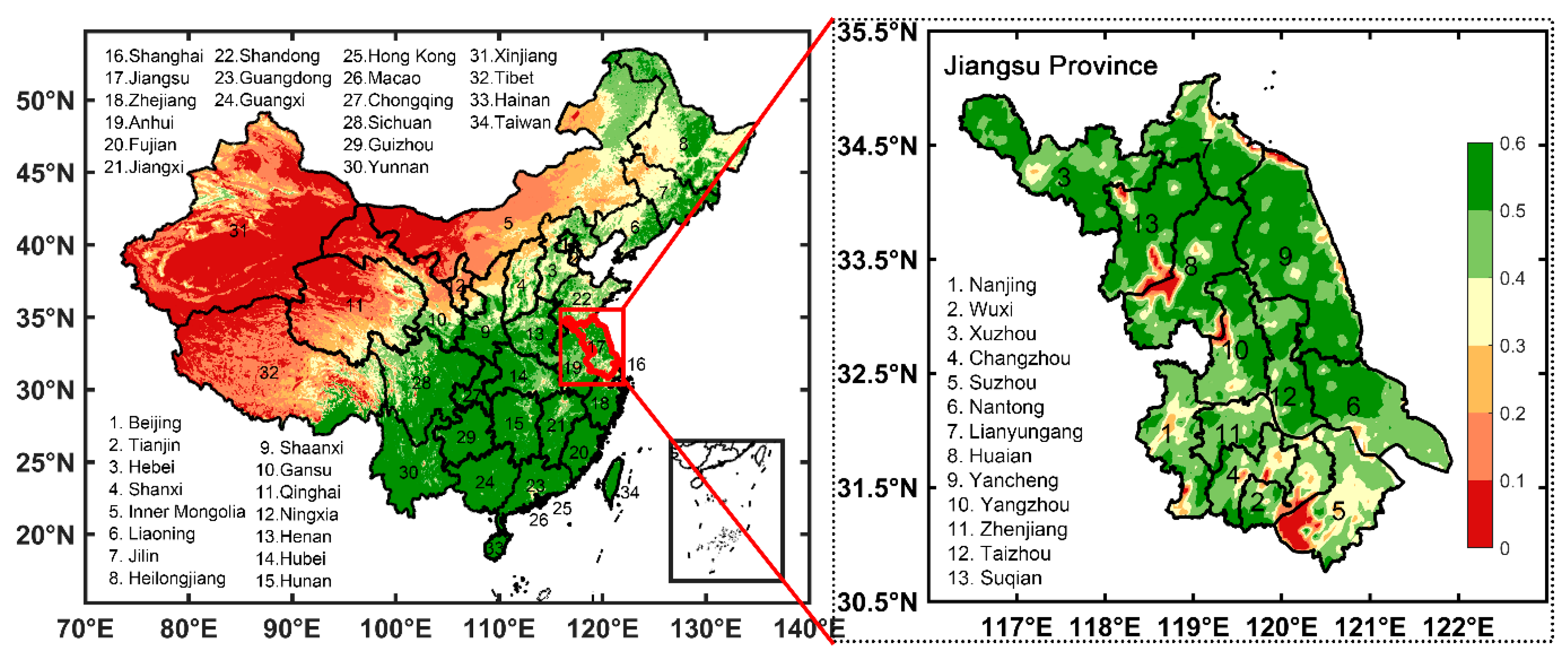
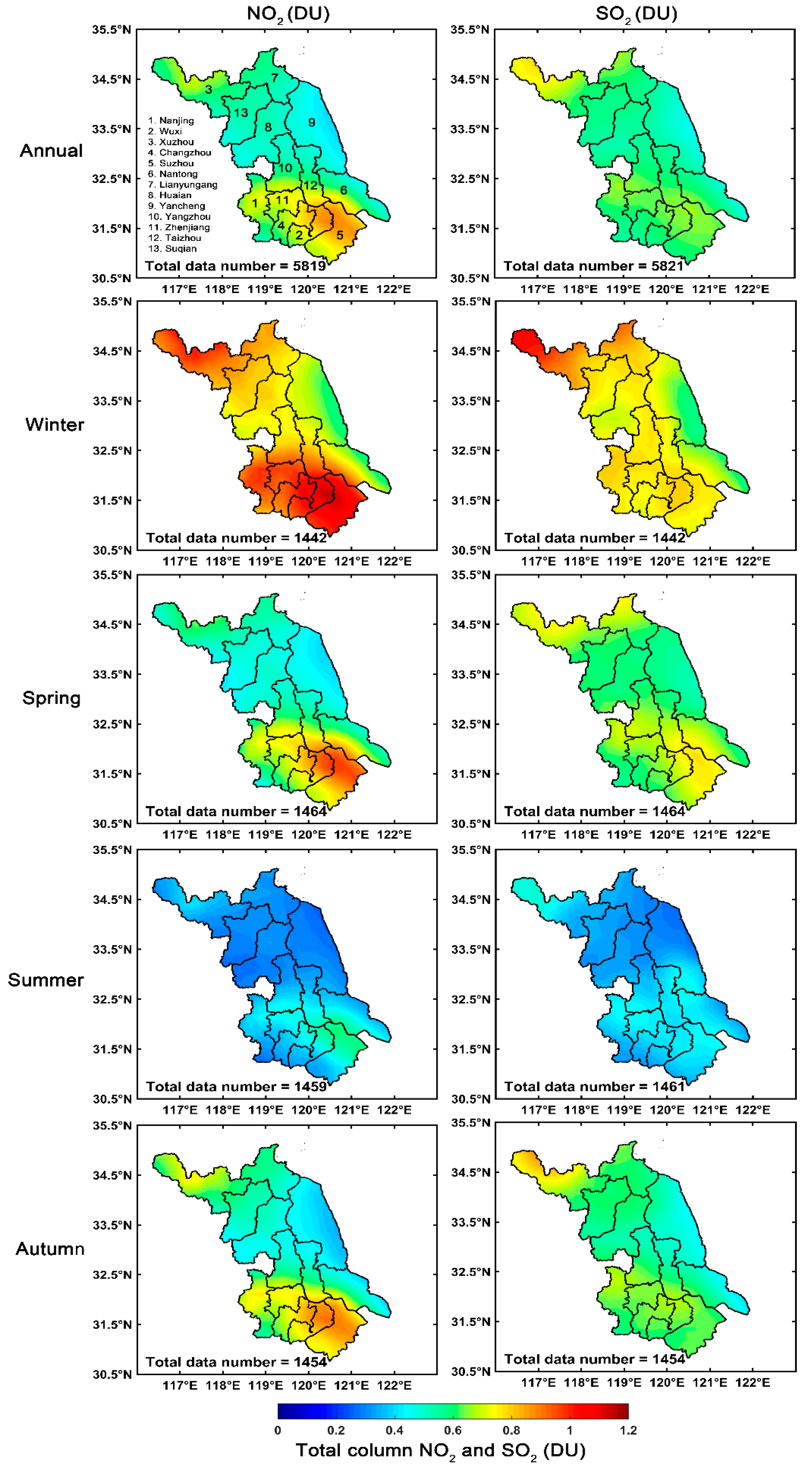
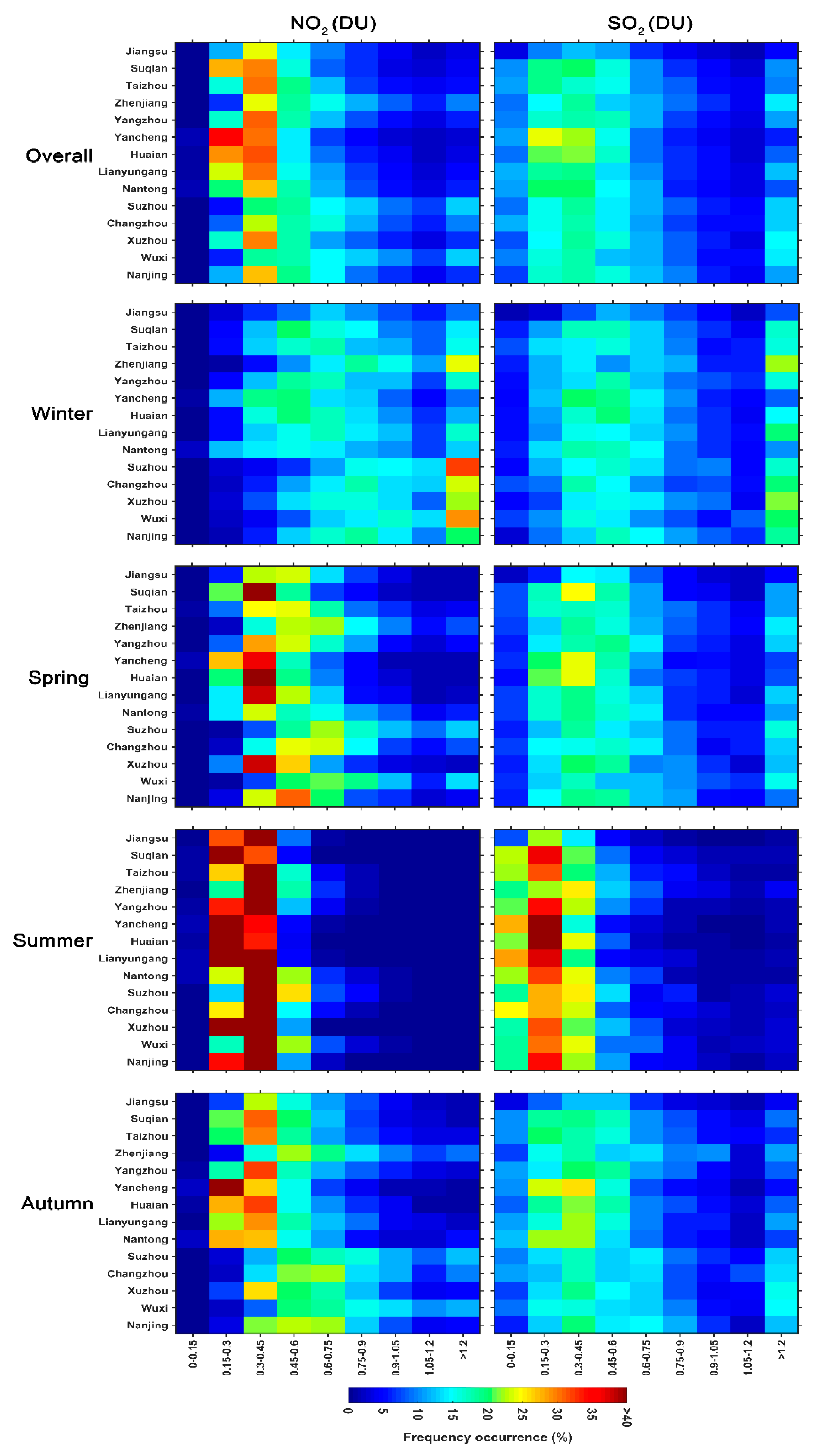
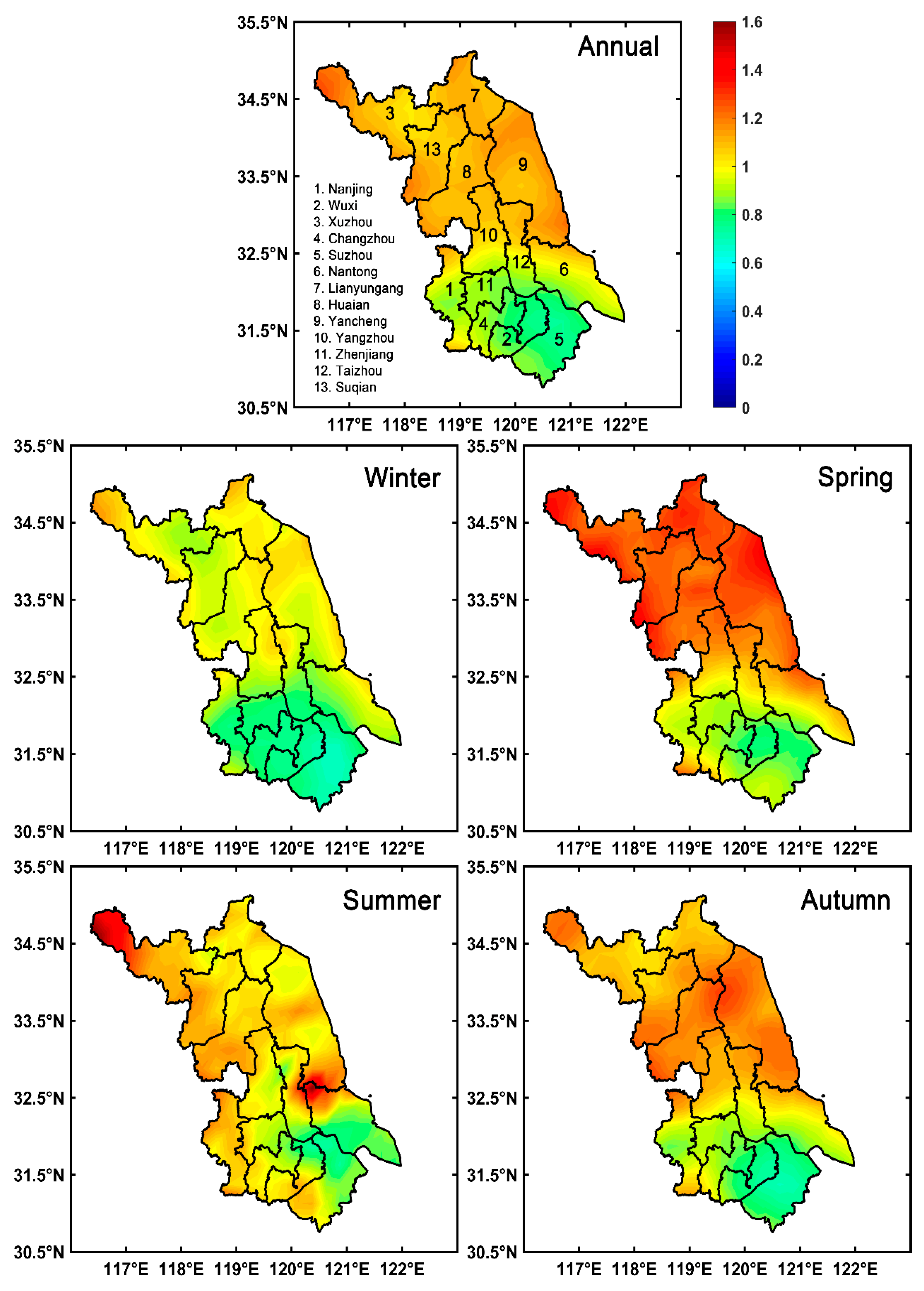
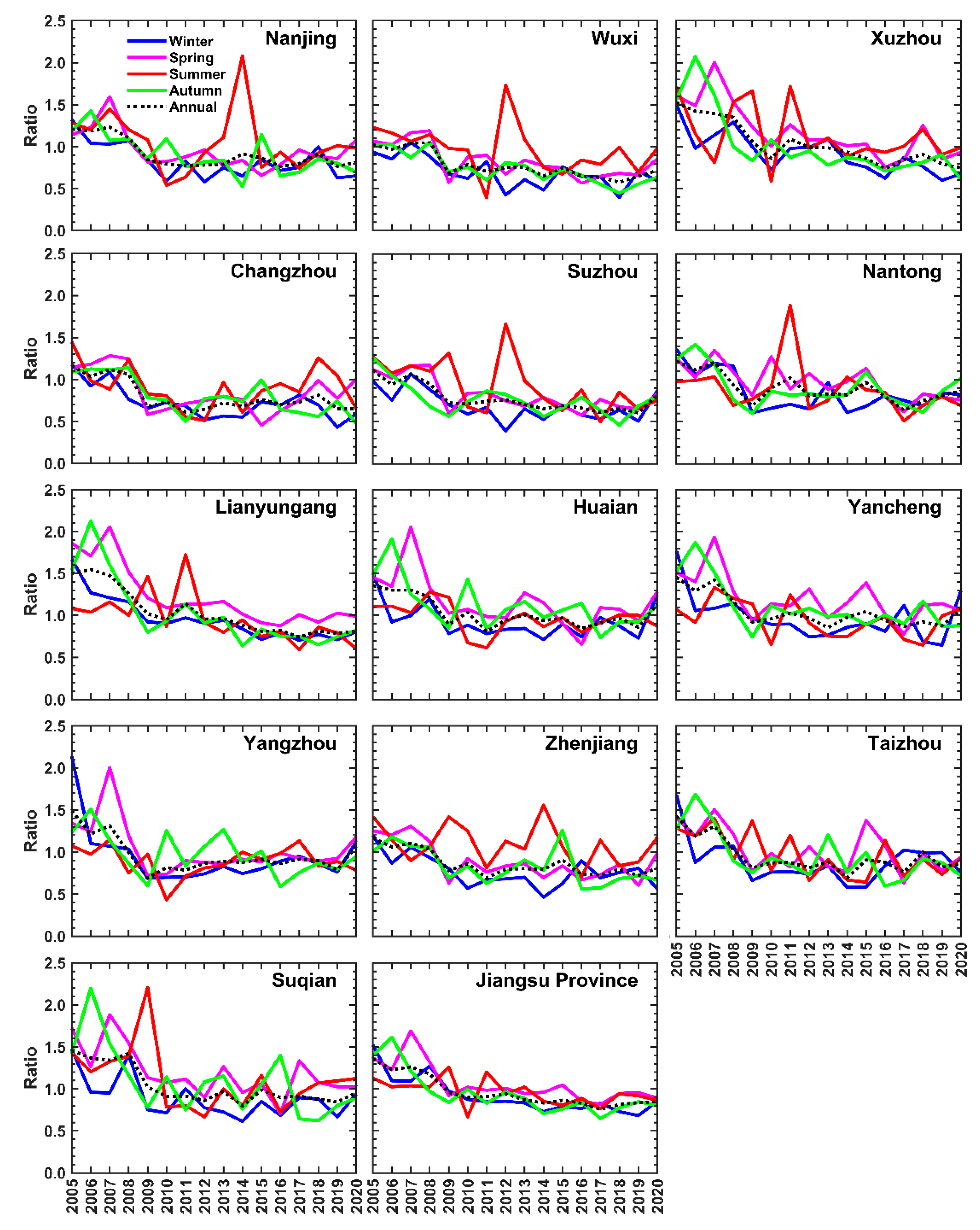
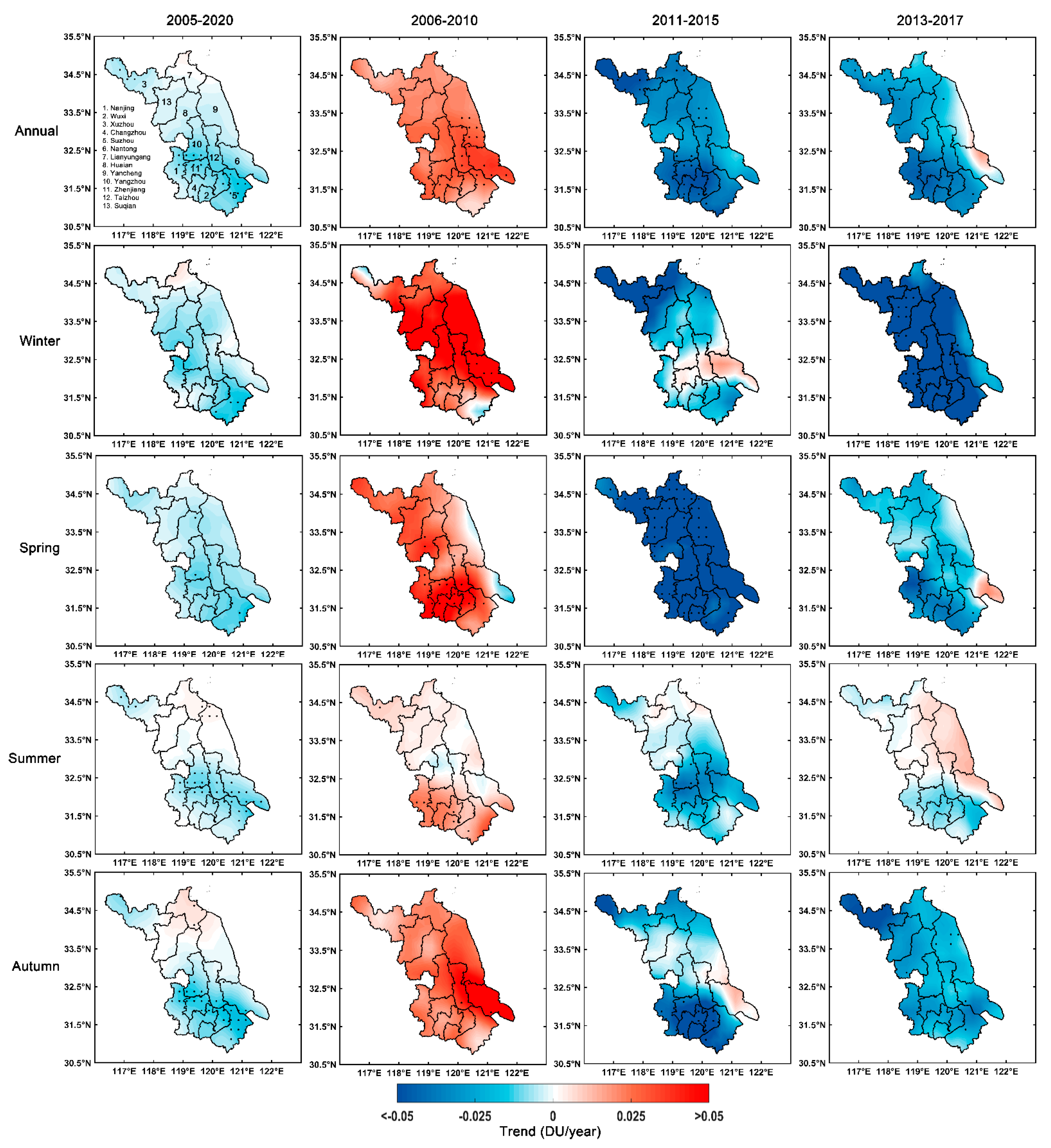
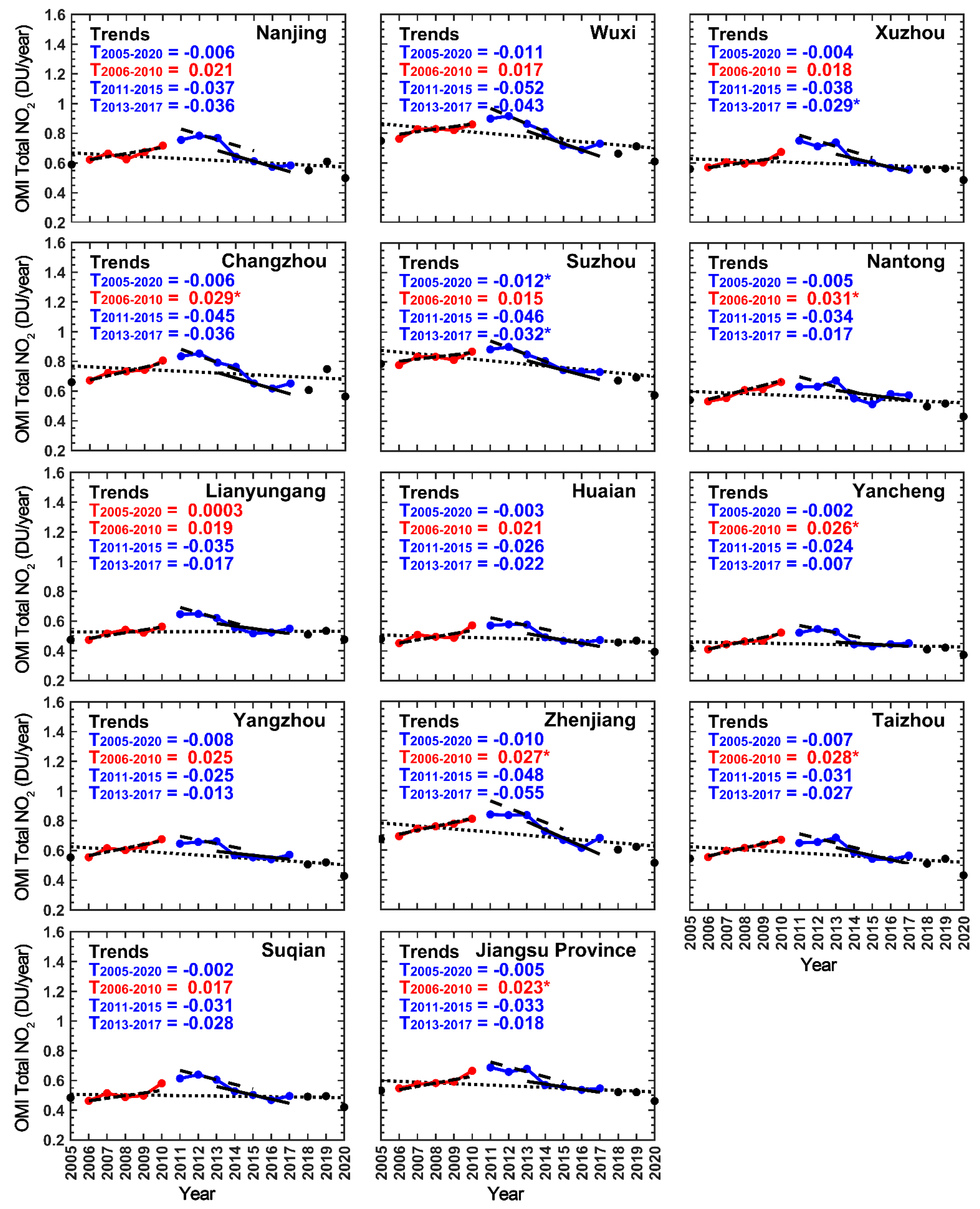

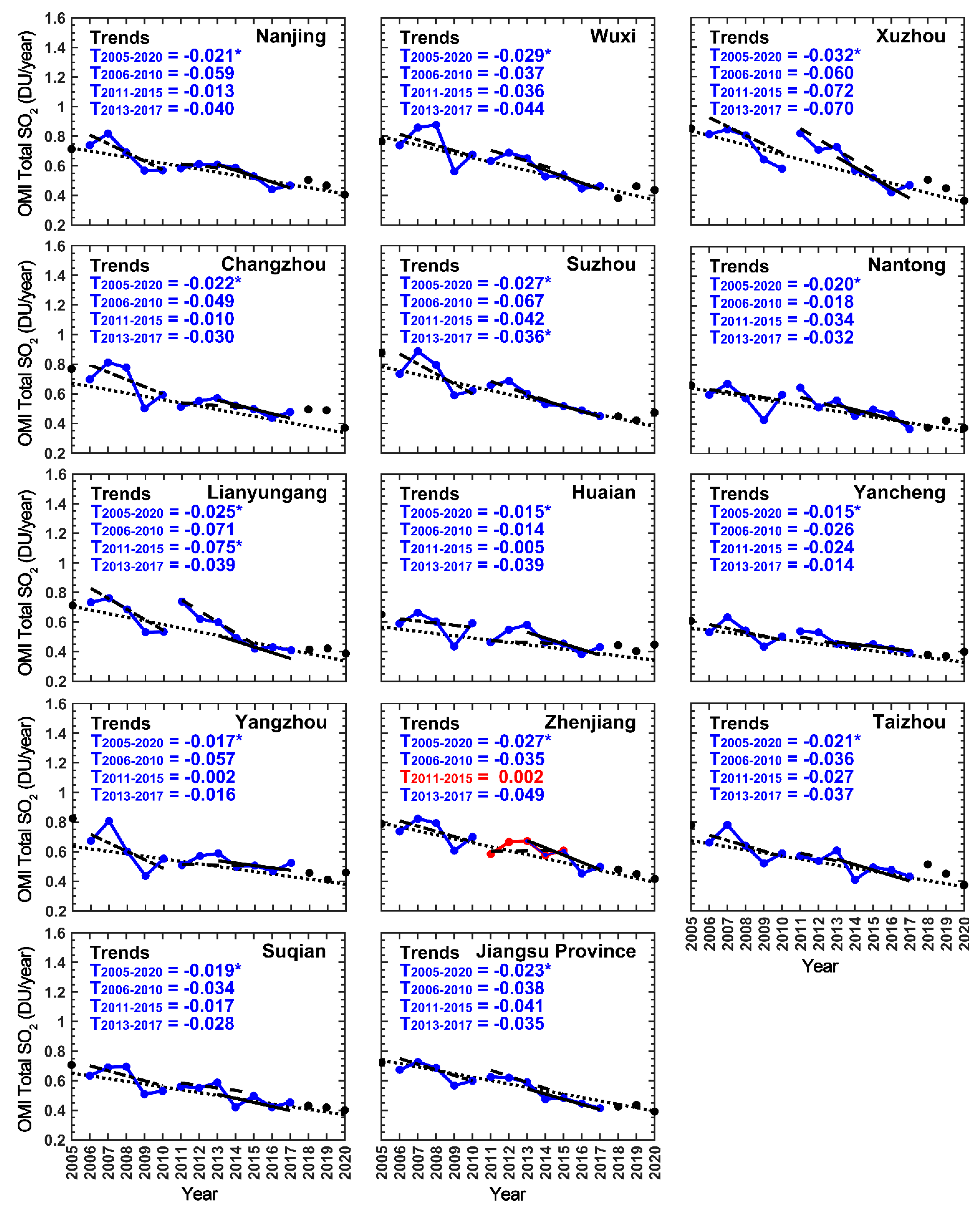

| Annual | Winter | Spring | Summer | Autumn | ||||||
|---|---|---|---|---|---|---|---|---|---|---|
| NO2 | SO2 | NO2 | SO2 | NO2 | SO2 | NO2 | SO2 | NO2 | SO2 | |
| Nanjing | 0.64 ± 0.08 | 0.58 ± 0.11 | 0.92 ± 0.14 | 0.75 ± 0.17 | 0.63 ± 0.10 | 0.60 ± 0.14 | 0.35 ± 0.04 | 0.37 ± 0.12 | 0.66 ± 0.07 | 0.60 ± 0.17 |
| Wuxi | 0.78 ± 0.09 | 0.61 ± 0.15 | 1.05 ± 0.13 | 0.72 ± 0.21 | 0.82 ± 0.10 | 0.68 ± 0.19 | 0.44 ± 0.05 | 0.42 ± 0.14 | 0.81 ± 0.09 | 0.60 ± 0.18 |
| Xuzhou | 0.61 ± 0.07 | 0.63 ± 0.16 | 0.92 ± 0.15 | 0.85 ± 0.25 | 0.54 ± 0.08 | 0.64 ± 0.19 | 0.33 ± 0.02 | 0.38 ± 0.12 | 0.64 ± 0.07 | 0.65 ± 0.24 |
| Changzhou | 0.71 ± 0.08 | 0.57 ± 0.13 | 0.99 ± 0.14 | 0.70 ± 0.18 | 0.73 ± 0.12 | 0.61 ± 0.16 | 0.39 ± 0.04 | 0.35 ± 0.08 | 0.75 ± 0.09 | 0.60 ± 0.18 |
| Suzhou | 0.78 ± 0.08 | 0.61 ± 0.15 | 1.04 ± 0.16 | 0.71 ± 0.20 | 0.83 ± 0.10 | 0.69 ± 0.19 | 0.45 ± 0.04 | 0.43 ± 0.15 | 0.80 ± 0.07 | 0.62 ± 0.17 |
| Nantong | 0.57 ± 0.06 | 0.51 ± 0.10 | 0.73 ± 0.12 | 0.61 ± 0.13 | 0.62 ± 0.08 | 0.61 ± 0.16 | 0.42 ± 0.04 | 0.37 ± 0.15 | 0.52 ± 0.07 | 0.46 ± 0.10 |
| Lianyungang | 0.54 ± 0.05 | 0.56 ± 0.13 | 0.82 ± 0.11 | 0.77 ± 0.18 | 0.51 ± 0.07 | 0.62 ± 0.17 | 0.31 ± 0.02 | 0.29 ± 0.09 | 0.53 ± 0.06 | 0.54 ± 0.17 |
| Huaian | 0.50 ± 0.05 | 0.51 ± 0.09 | 0.75 ± 0.11 | 0.69 ± 0.14 | 0.47 ± 0.07 | 0.55 ± 0.15 | 0.29 ± 0.01 | 0.28 ± 0.05 | 0.47 ± 0.04 | 0.52 ± 0.13 |
| Yancheng | 0.46 ± 0.05 | 0.48 ± 0.08 | 0.66 ± 0.11 | 0.63 ± 0.12 | 0.45 ± 0.07 | 0.54 ± 0.13 | 0.30 ± 0.01 | 0.28 ± 0.06 | 0.42 ± 0.05 | 0.45 ± 0.09 |
| Yangzhou | 0.58 ± 0.06 | 0.56 ± 0.12 | 0.82 ± 0.11 | 0.75 ± 0.21 | 0.60 ± 0.09 | 0.62 ± 0.18 | 0.36 ± 0.04 | 0.32 ± 0.07 | 0.54 ± 0.06 | 0.53 ± 0.15 |
| Zhenjiang | 0.71 ± 0.09 | 0.62 ± 0.13 | 0.97 ± 0.14 | 0.74 ± 0.18 | 0.73 ± 0.12 | 0.65 ± 0.17 | 0.42 ± 0.05 | 0.46 ± 0.12 | 0.73 ± 0.09 | 0.61 ± 0.17 |
| Taizhou | 0.58 ± 0.07 | 0.55 ± 0.12 | 0.80 ± 0.12 | 0.70 ± 0.17 | 0.61 ± 0.09 | 0.62 ± 0.16 | 0.38 ± 0.03 | 0.37 ± 0.11 | 0.55 ± 0.06 | 0.52 ± 0.15 |
| Suqian | 0.52 ± 0.06 | 0.53 ± 0.10 | 0.79 ± 0.13 | 0.70 ± 0.18 | 0.47 ± 0.07 | 0.56 ± 0.15 | 0.29 ± 0.02 | 0.32 ± 0.10 | 0.51 ± 0.04 | 0.55 ± 0.17 |
| Jiangsu Province | 0.58 ± 0.06 | 0.56 ± 0.11 | 0.83 ± 0.12 | 0.75 ± 0.16 | 0.56 ± 0.08 | 0.60 ± 0.15 | 0.34 ± 0.02 | 0.33 ± 0.06 | 0.58 ± 0.05 | 0.54 ± 0.14 |
Publisher’s Note: MDPI stays neutral with regard to jurisdictional claims in published maps and institutional affiliations. |
© 2021 by the authors. Licensee MDPI, Basel, Switzerland. This article is an open access article distributed under the terms and conditions of the Creative Commons Attribution (CC BY) license (https://creativecommons.org/licenses/by/4.0/).
Share and Cite
Wang, Y.; Ali, M.A.; Bilal, M.; Qiu, Z.; Mhawish, A.; Almazroui, M.; Shahid, S.; Islam, M.N.; Zhang, Y.; Haque, M.N. Identification of NO2 and SO2 Pollution Hotspots and Sources in Jiangsu Province of China. Remote Sens. 2021, 13, 3742. https://doi.org/10.3390/rs13183742
Wang Y, Ali MA, Bilal M, Qiu Z, Mhawish A, Almazroui M, Shahid S, Islam MN, Zhang Y, Haque MN. Identification of NO2 and SO2 Pollution Hotspots and Sources in Jiangsu Province of China. Remote Sensing. 2021; 13(18):3742. https://doi.org/10.3390/rs13183742
Chicago/Turabian StyleWang, Yu, Md. Arfan Ali, Muhammad Bilal, Zhongfeng Qiu, Alaa Mhawish, Mansour Almazroui, Shamsuddin Shahid, M. Nazrul Islam, Yuanzhi Zhang, and Md. Nazmul Haque. 2021. "Identification of NO2 and SO2 Pollution Hotspots and Sources in Jiangsu Province of China" Remote Sensing 13, no. 18: 3742. https://doi.org/10.3390/rs13183742
APA StyleWang, Y., Ali, M. A., Bilal, M., Qiu, Z., Mhawish, A., Almazroui, M., Shahid, S., Islam, M. N., Zhang, Y., & Haque, M. N. (2021). Identification of NO2 and SO2 Pollution Hotspots and Sources in Jiangsu Province of China. Remote Sensing, 13(18), 3742. https://doi.org/10.3390/rs13183742












